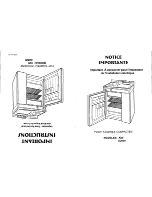
21
1. Before reversing the refrigerator doors,
unplug the device and remove the food
and all removable accessories like
shelves and drawers from the
refrigerator.
2. Do not lay the refrigerator down on the
floor.
3. Be careful to not drop the door while
disassembling and reassembling the
refrigerator.
ATTENTION!
REFRIGERATOR FEATURES
ANTI-CONDENSATION PIPE:
•
The anti-condensation pipe is located inside
the refrigerator body and around the front
side of the refrigerator to prevent
condensation.
•
In these places, the refrigerator may heat
up, especially the first time it is turned on or
when the outside temperature is high.
Anti-condensation pipe
If you need to reverse the doors, you
should call a service technician. The
warranty does not cover door reversal.
NOTE
REVERSIBLE DOORS
The refrigerator is designed so that the doors
can open to the right or to the left depending
on how it fits into your kitchen.
REQUIRED TOOLS:
• 10 mm and 6 mm wrenches;
• 5 mm hex wrench;
• Crosstip screwdriver.
• Remove the upper cover (2) of the
refrigerator compartment door by
removing the screws (1).
• Move the plug (3) to the opposite side of
the upper cover (2).
• Disconnect the connector cable (4).
• After removing the screws (5), pull it
forward and lift the cover without
damaging the wire (6).
• Remove the wire holder (7) and attach it to
the center of the cover (6).
• Install the plug (9) on the opposite side of
the cover (6).
(1)
(1)
(2)
(3)
(4)
As a result of temperature-induced
deformations of refrigerator components, you
may hear a slight crackling noise. Sounds
typically heard when a thermal regulator or
compressor turns on are normal and may be
heard during the operation of any electrical
device.
The refrigerant circulating inside the
refrigeration system may produce a slight
gurgling sound, even if the compressor is off.
Do not worry, it is absolutely normal. During
refrigerator operation, you may hear:
- Rustling fan blades;
- The temperature relay sensor clicking;
- The air damper actuator buzzing;
- A gurgling sound produced by refrigerant
circulating inside refrigeration system
pipes;
- A slight crackling when materials deform
due to temperature changes.
These noises are not related to any defect
and are operational in nature.
CARE AND MAINTENANCE








































